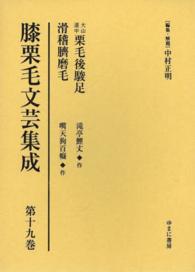- ホーム
- > 洋書
- > 英文書
- > Science / Mathematics
Full Description
The only book available for the reservoir or petroleum engineer covering formation testing—with algorithms for wireline and LWD reservoir analysis developed for transient pressure, contamination modeling, permeability, and pore pressure prediction.
Traditional well logging methods, such as resistivity, acoustic, nuclear, and NMR, provide indirect information relating to fluid and formation properties. However, the "formation tester" offered in wireline and MWD/LWD operations is different. It collects actual downhole fluid samples for surface analysis, and through pressure transient analysis, provides direct measurements for pore pressure, mobility, permeability, and anisotropy. These are vital to real-time drilling safety, geosteering, hydraulic fracturing, and economic analysis.
Methods for formation testing analysis, while commercially important and accounting for a substantial part of service company profits, are shrouded in secrecy. Many are poorly constructed, and because details are not available, industry researchers are not able to improve on them. Formation Testing explains conventional models and develops new, more powerful algorithms for early-time analysis. More importantly, it addresses a critical area in sampling related to "time required to pump clean samples," using rigorous multiphase flow techniques. All of the methods are explained in complete detail. Equations are offered for users to incorporate in their own models, but, for those needing immediate answers, convenient, easy-to-use software is available.
The lead author is a well-known petrophysicist with hands-on experience at Schlumberger, Halliburton, BP Exploration, and other companies. His work is used commercially at major oil service companies, and important extensions to his formation testing models have been supported by prestigious grants from the U.S. Department of Energy. His latest collaboration with China National Offshore Oil Corporation marks an important turning point, where advanced simulation models and hardware are evolving side-by-side, defining a new generation of formation testing logging instruments. Providing more than formulations and solutions, this book offers a close look at "behind the scenes" formation tester development, as the China National Offshore Oil Corporation opens up its research, engineering, and manufacturing facilities through a collection of never-before-seen photographs, showing how formation testing tools are developed from start to finish.
Contents
Opening Message xix
Preface xxi
Acknowledgements xxvii
Part 1 Modern Ideas in Job Planning and Execution
1. Basic Ideas, Challenges and Developments 1
1.1 Background and introduction 1
1.2 Existing models, implicit assumptions and limitations 6
1.3 Tool development, testing and deployment - role of modeling and "behind the scenes" at CNOOC/COSL 15
1.4 Book objectives and presentation plan 29
1.5 References 32
2. Forward Pressure and Contamination Analysis in Single and Multiphase Compressible Flow 34
2.1 Single-phase source fl ow models 34
2.2 Dual packer and dual probe flows 40
2.3 Supercharging, mudcake growth and pressure interpretation 45
2.4 Boundary and azimuthal effects in horizontal wells 48
2.5 Contamination clean-up at the source probe 49
2.6 Sampling-while-drilling tools and clean-up efficiency 51
2.7 References 55
3. Inverse Methods for Permeability, Anisotropy and Formation Boundary Effects Assuming Liquids 56
3.1 New inverse methods summary 56
3.2 New inverse modeling capabilities 57
3.3 Inverse examples - dip angle, multivalued solutions and skin 62
3.4 Computational notes on complex complementary error function evaluation 70
3.5 Source model - analytical and physical limitations 72
3.6 Full three-dimensional transient Darcy fl ow model for horizontal wells 72
3.7 Phase delay inverse method and electromagnetic analogy 75
3.8 Source model applications to dual packers 76
3.9 Closing remarks 76
3.10 References 77
Part II Math Models, Results and Detailed Examples
4. Multiphase Flow and Contamination - Transient Immiscible and Miscible Modeling with Fluid Compressibility 78
4.1 Invasion, supercharging and multiphase pumping 79
4.2 Mathematical formulation and numerical solution 86
4.3 Miscible fl ow formulation 96
4.4 Three-dimensional fl ow extensions 97
4.5 Computational implementation for azimuthal effects 98
4.6 Modeling long-time invasion and mudcake scrape-off 99
4.7 Software features 99
4.8 Calculated miscible fl ow pressures and concentrations 100
4.9 Calculated immiscible fl ow clean-up examples 116
4.10 Closing remarks 118
4.11 References 119
5. Exact Pressure Transient Analysis for Liquids in Anisotropic Homogeneous Media, Including Flowline Storage Effects, With and Without Skin at Arbitrary Dip Angles 121
5.1 Background and objectives 122
5.2 Detailed pressure transient examples (twenty!) - competing effects of nisotropy, skin, dip and flowline storage 130
5.3 Software operational details and user interface 146
5.4 Closing remarks 156
5.5 Appendix - Mathematical model and numerical implementation 159
6. Permeability Interpretation for Liquids in Anisotropic Media,Including Flowline Storage Effects, With and Without Skin at Arbitrary Dip Angles 196
6.1 Six new inverse methods summarized 196
6.2 Existing inverse methods and limitations 198
6.3 Permeability anisotropy theory without skin (ellipsoidal source) 201
6.4 Zero skin permeability prediction examples (ellipsoidal source) 209
6.5 Permeability anisotropy with skin effects (ellipsoidal source) 217
6.6 Non-zero skin permeability prediction examples (ellipsoidal source) 219
6.7 Low permeability pulse interference testing (ellipsoidal source) -getting results with short test times 225
6.8 Fully three-dimensional inverse methods 238
6.9 Software interface for steady inverse methods (ellipsoidal source) 245
6.10 Formation testing while drilling (FTWD) 251
6.11 Closing remarks 271
6.12 References 273
7. Three-Dimensional Pads and Dual Packers on Real Tools with Flowline Storage in Layered Anisotropic Media for Horizontal Well Single-Phase Liquid and Gas Flows 274
7.1 Pad and dual pad models for horizontal well application 274
7.2 Fundamental ideas in fi nite difference modeling 280
7.3 Mathematical formulation and geometric transformations 286
7.4 Meshing algorithm construction details 303
7.5 Three-dimensional calculations and validations 306
7.6 User interface and extended capabilities 330
7.7 Closing remarks 335
7.8 References 336
8. Gas Pumping: Forward and Inverse Methods in Anisotropic Media at Arbitrary Dip Angles for Point Source, Straddle Packer and Real Nozzles 337
8.1 Gas reservoir pumping basics and modeling objectives 338
8.2 Direct and inverse formulations for ellipsoidal source 340
8.3 Ellipsoidal source - exact steady forward and inverse solutions 343
8.4 Special analytical results 347
8.5 Direct solver, solution procedure 349
8.6 Forward model gas calculations 350
8.7 Second-order schemes 353
8.8 Inverse solver, solution software 353
8.9 Inverse gas calculations 355
8.10 Ellipsoidal source - fully transient numerical solutions for gases and liquids 358
8.11 Transient source pulse interaction inverse method 369
8.12 Ring source, layered model for vertical wells 372
8.13 Pad nozzle and dual packer sources for horizontal wells 381
8.14 Application to modern gas reservoir characterization 383
8.15 References 383
9. Three-Dimensional Phase Delay Response in Layered Anisotropic Media with Dip 385
9.1 Basic phase delay and amplitude attenuation ideas 385
9.2 Layered model formulation 387
9.3 Phase delay software interface 392
9.4 Detailed phase delay results in layered anisotropic media 396
9.5 Closing remarks - extensions and additional applications 404
9.6 References 406
Part III Consulting Services and Advanced Software
Consulting services and advanced software 407
Module FT-00 408
Module FT-01 410
Module FT-02 412
Module FT-03 414
Module FT-04 418
Module FT-05 420
Module FT-06 421
Module FT-07 423
Module FT-PTA-DDBU 425
Part IV Cumulative References, Index and Author Contact
Cumulative References 426
Index 431
About the Authors 439








